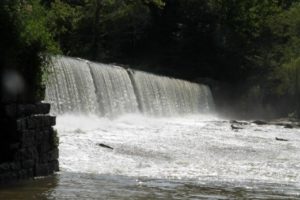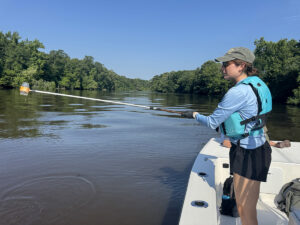News

by Matthew Starr
This year is a milestone for the Neuse River. For the first time in over 100 years the Neuse River is free flowing for its more than 200 mile journey to the Pamlico Sound. The Milburnie Dam, which sits on the Neuse just outside of Raleigh, has come down and the river has now returned to its natural free flowing state. Fish, such as Shad and Striped Bass, will now be able to spawn in areas upstream they haven’t inhabited since the 1700’s.
more than 200 mile journey to the Pamlico Sound. The Milburnie Dam, which sits on the Neuse just outside of Raleigh, has come down and the river has now returned to its natural free flowing state. Fish, such as Shad and Striped Bass, will now be able to spawn in areas upstream they haven’t inhabited since the 1700’s.
The removal of Milburnie is not just a huge positive for the environment, it’s also a big win for recreation and public safety. Boaters will no longer have to portage around the dam and swimmers and fishermen will be much safer from the churning water that the dam created, which caused numerous deaths throughout the years.
Sound Rivers and your Upper Neuse Riverkeeper have been working to remove Milburnie for years and on November 15 the cumulation of that work paid off as the first stone was removed by Restoration Systems.
 The Milburnie Dam has a rich history; the earliest known Milburnie Dam location was originally the site of an 18th century grist mill owned by Colonel John Hinton (1715-1784.) It was replaced around 1855 by a paper mill that was burned by Union troops in 1865. Following the burning of the papermill, a gristmill and sawmill were at this location until 1880 when the timber dam washed away. Raleigh Ice & Electric Company bought the property and built a new stone dam sometime between 1900 and 1903. The hydroelectric facility was bought by CP&L in 1916 and dismantled in 1918. The current owner of the Milburnie Dam reported that his father, S. W. Twiggs, bought the property in 1934 and operated a gristmill until the early 1940s when the mill shut down. The gristmill building later burned and the only remains were mill stones, mill pulleys, and brick walls. In the late 1970s, the property was leased to a Pennsylvania company, which invested about $2 million to build a hydroelectric plant, known as the Milburnie Hydroelectric Project. It became operational in 1984 and then went out of business sometime between 2006 and 2009.
The Milburnie Dam has a rich history; the earliest known Milburnie Dam location was originally the site of an 18th century grist mill owned by Colonel John Hinton (1715-1784.) It was replaced around 1855 by a paper mill that was burned by Union troops in 1865. Following the burning of the papermill, a gristmill and sawmill were at this location until 1880 when the timber dam washed away. Raleigh Ice & Electric Company bought the property and built a new stone dam sometime between 1900 and 1903. The hydroelectric facility was bought by CP&L in 1916 and dismantled in 1918. The current owner of the Milburnie Dam reported that his father, S. W. Twiggs, bought the property in 1934 and operated a gristmill until the early 1940s when the mill shut down. The gristmill building later burned and the only remains were mill stones, mill pulleys, and brick walls. In the late 1970s, the property was leased to a Pennsylvania company, which invested about $2 million to build a hydroelectric plant, known as the Milburnie Hydroelectric Project. It became operational in 1984 and then went out of business sometime between 2006 and 2009.

For now, when you visit the old dam site, you will still be able to appreciate this important, historical landmark as some of the dam’s foundation will be left behind. But you will now be able to swim, boat, and fish without the threat the dam created, not only to the environment but to public safety. I hope to see you out there come spring!
More information: https://milburniedam.com/
Related News

Specialist investigates lake connection to mysterious skin rash
July 10th 2025

Riverkeeper: Central NC flooding part of a much larger issue
July 10th 2025

N.C. Governor vetoes bad rulemaking bill
July 10th 2025

Riverkeeper, program director ‘Growing More than Rain Gardens’
July 10th 2025

Volunteer coordinator goes ‘fishing’
July 10th 2025

Neuse fish kill expected to extend beyond holiday weekend
July 3rd 2025

Swim Guide fails prompt Maple Cypress investigation
July 3rd 2025

Riverkeeper, town partners root out source of Smithfield sediment pollution
July 3rd 2025

